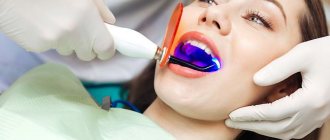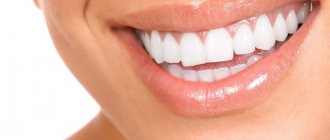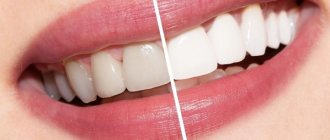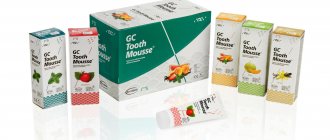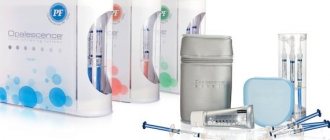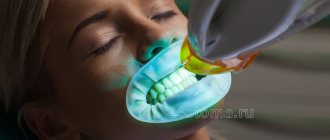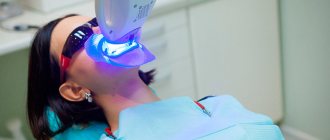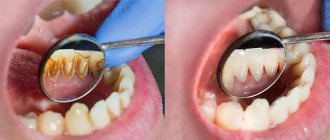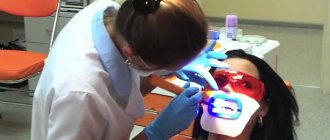Probably many people have encountered the problem of dark tooth enamel. Enamel loses its whiteness for various reasons: poor personal hygiene, poor diet, bad habits (alcohol, cigarettes), illness. Today, a large number of clinics offer to restore the whiteness of teeth in various ways. Let's try to figure out how these methods work, how effective they are and whether they have a detrimental effect on the condition of teeth and on the human body as a whole.
What is whitening
Today, there is no consensus among dentists whether teeth whitening is harmful or beneficial. Some experts claim that it does not cause any harm to the human body, whitening methods are effective, and a beautiful smile only gives confidence and improves mood. Other dentists are skeptical about the whitening process.
In modern dentistry, there are both clinical methods of teeth whitening and “at-home” techniques. In general, whitening is understood as the process of lightening tooth enamel by a certain number of tones - some people prefer to simply remove yellowness, while others want to achieve an unnatural white shade.
Methods for lightening enamel by removing pigmented plaque
If the problem with the shade of the enamel is the presence of dental plaque, methods for removing it come to the rescue. It is worth noting that very often this is more than enough and you don’t even have to resort to a professional whitening technique.
Ultrasonic cleaning
This is not an independent whitening method; ultrasonic cleaning is a method of removing hard plaque from teeth. Tartar changes the shade of the enamel, so in some cases it is enough to remove the tartar to achieve noticeable lightening.
Air Flow
Just like ultrasonic cleaning, this method is a method of mechanical cleaning of soft pigmented plaque, which allows the enamel to return its own shade. It consists of removing deposits with a jet of a special mixture of water, air and abrasive particles. If necessary, two methods - ultrasound and Air Flow, can be effectively combined with each other.
Please note: even if there is no goal to brighten your smile in this way, you will have to undergo professional cleaning before any of the selected whitening procedures. This preparation will allow the gel to better penetrate deep structures and make the whitening session more effective.
How safe is teeth whitening?
The answer to this question directly depends on the bleaching method. Cleaning with chemicals, mechanical means, gels and pastes have different effects on both our teeth and the general condition of the body. In addition, you need to select the whitening method individually, focusing on the characteristics of the body and susceptibility to allergies.
Also remember that during whitening (regardless of the method), the enamel wears off and becomes thinner, teeth lose their natural strength and are more susceptible to destruction. Yellow enamel is stronger, so you should not whiten your teeth too often - this can lead to significant thinning of the enamel. On average, you can whiten your teeth once or twice a year, but again, you need to consult with your dentist. Some chemicals can also soften the enamel and make it loose and porous, so consultation with a specialist before the procedure is mandatory. The doctor will not only select the most optimal option for you, taking into account its characteristics, but will also find out individual intolerance to individual components, possible allergic reactions, and determine the condition of the teeth before the procedure.
The power of a smile
Facts about laughter
- 10-15 minutes of laughter burns the equivalent of a 100g chocolate bar.
- 100 km/h - this is the speed at which air escapes from the lungs when laughing.
- 17 minutes of laughter a day prolongs life by one year.
- Cheerful people are 40% less likely to suffer from heart disease.
- A person uses 17 facial muscles to smile, and 43 to frown.
- The most smiling people live in Brazil and Cuba.
- 69% of men consider women with an open smile attractive, preferably without makeup.
Laughter is the best medicine. Do you think this is just a figurative expression? Not at all. This is a proven fact! Laughter relieves stress and lifts your spirits, and recent research has shown that it can even fight disease.
While all social gestures of acceptance - handshakes, hugs, head nods - have multiple interpretations depending on cultural traditions in different countries, smiling is a universal sign of happiness, interpreted positively in all languages of the world. A snow-white smile is a sign of not only happy people, but also successful people.
Teeth whitening techniques
Today there are two such methods:
- Mechanical cleaning is simply cleaning your teeth with a toothbrush and a special whitening paste. Using a brush, we remove plaque from tooth enamel and make it clean. Of course, this method does not cause any harm and is considered the safest. However, it increases the whiteness of teeth by no more than two shades, and cannot remove everything - for example, some pigments from tea, coffee, and cigarettes remain on the enamel. They can only be combated with chemicals.
- Chemical influence on the color of tooth enamel - this process is carried out in the dentist's office and can be done in different ways. There are also some home methods of chemical exposure - for example, the use of special pastes and gels, as well as whitening strips.
Contacting the Doctor Martin Clinic
In Moscow, teeth whitening is offered by the reliable dentistry “Doctor Martin”. Experienced specialists perform procedures efficiently and safely. At the initial appointment, the doctor will examine the teeth, agree with the patient on the desired enamel color and perform whitening. Each patient will leave the clinic completely satisfied with the results obtained. The pricing policy of Doctor Martin dentistry is loyal, the cost of the service is lower than in other private clinics in the city (you can find out more about the price list on the website). To sign up for the procedure, just call the phone number provided or fill out a standard form online.
Teeth whitening at the dentist
The safety of this method is ensured by the supervision of a specialist at all stages of bleaching.
Typically, teeth whitening at the dentist begins with ultrasonic cleaning. It effectively copes with various “dental debris”, including tartar. After brushing, the process of polishing the teeth follows to ensure a smooth surface of the tooth enamel.
Ultrasonic cleaning does not harm either the teeth or the body as a whole, and removing tartar from tooth enamel will only have a beneficial effect on the condition of your teeth.
Zoom whitening: harm or benefit?
Zoom photobleaching is a popular and relatively inexpensive method. The session will cost you approximately 15,000 rubles. But how safe is it?
The role of the catalyst is played by the LED lamp. The risk is that intense hot light can cause overheating and death of the pulp (neurovascular bundle).
The duration of the session should not exceed one hour, and the specialist should promptly change lamps that have expired.
There is good news: the composition of the whitening gel used for the Zoom procedure includes useful minerals - calcium, fluoride, which strengthen tooth enamel.
Whitening systems
Today doctors can offer several whitening options:
- Air Flow – processes tooth enamel using the principle of sandblasting. Bleaching is carried out using soda and water. The jet of the composition is supplied under high pressure, thereby effectively cleaning and whitening tooth enamel. After the first half-hour procedure, your teeth will become whiter. However, this method is not suitable for those whose teeth are hypersensitive.
- With mouthguards - available both with and without hydrogen peroxide. This is a chemical effect on the teeth, which has a tangible and visible effect, and the harm from such an effect is much less than from soda.
- Zoom is the most popular type, which is actively offered in many dental clinics today. A special gel is applied to the tooth enamel, which is activated (fixed) by a lamp.
- Photobleaching – the principle of this system is similar to the Zoom system. Here, too, a gel is applied to the tooth enamel, but it is fixed with another lamp – an ultraviolet one.
- Laser system - its principle is similar to the previous two, but here the gel is activated more efficiently due to a denser beam of light. In addition, if in other systems the tooth surface heats up during the whitening process, this is not the case here. This allows you to avoid damaging your nerves and keep your teeth healthy.
How does the procedure work?
The main preparation before the whitening procedure, which guarantees uniform lightening of the enamel, is teeth cleaning (“Air Flow” and ultrasound). Professional whitening is carried out in a regular dental chair. Initially, it is necessary to isolate the mucous membrane so that the bleaching agent does not come into contact with it. Next, the doctor applies it to the teeth (for about 20 minutes) and uses a special lamp. This procedure is repeated several times, completely washing off the composition. The average duration of the entire procedure is 1.5 hours. It does not cause any painful sensations. Some patients feel a slight tingling sensation - this is a normal reaction.
The procedure has a cumulative effect - oxygen continues to work on the teeth behind the doors of the dental office. The final result can be assessed after 1-2 weeks. It is important to adhere to a “white” diet for the first 2-3 days after the procedure: give up coffee, black tea, red wine and any coloring products. The resulting effect will last about 2-3 years (if you regularly sign up for professional hygiene every six months).
Teeth whitening at home
Whitening at home will be effective and safe when you do it under the supervision of a dentist. Visit a specialist and get advice on what type of whitening is best for you and how often the procedure should be done. Doing this is extremely important, since you can only harm your body on your own.
You can whiten your home using baking soda, lemon juice, activated carbon, peroxide, and berries (for example, strawberries). Also today there are a variety of whitening toothpastes, gels, and kits on sale, which also include a special tray for easy whitening. Whitening strips are also popular - this product came to us from America, where it was actively used at the end of the last century. These strips are simple and easy to use: after eating, stick them on your teeth and walk with them for several hours (it would even be better to do this at night). The effect is noticeable after the first use.
Before using any product, you should definitely consult a doctor, because each product has its own contraindications: for example, strips are contraindicated during pregnancy, and not everything may be suitable for children and allergy sufferers. In addition, if you have very sensitive teeth, you should choose a soft, gentle option that will not damage tooth enamel or spoil your teeth.
Types of whitening and how they differ from each other
There are several types of whitening: home, clinical (professional) and intracoronal. Professional whitening is the fastest way to get results. The procedure lasts about an hour and is carried out under the supervision of a doctor using equipment to activate the whitening gel (laser or special lamps). Intracoronal whitening is also performed by a doctor on only one tooth that has changed color - for example, after injury or root canal treatment. Home whitening takes from several weeks to a month. In this case, mouthguards and whitening gel are more often used. Whitening pastes are ineffective and you cannot achieve a noticeable result with their help.
What can interfere with teeth whitening?
In some cases, dental fillings can become such an obstacle. We are talking about those that stand in the teeth of the front row. If the filling is located in the back row of teeth, then it will not interfere with whitening. After the procedure, it will not change its color, but this will not be noticeable due to the fact that it is located far away. But if the filling is located on the front teeth, then the difference after whitening can be significant: the teeth will become one shade, and the filling will become another. Also, whitening is usually not carried out if a crown is installed on the front teeth, because it does not change its color during bleaching and after the procedure will differ significantly from the main teeth.
However, today there are ways to whiten teeth with fillings and crowns. They are more expensive than classic whitening and take longer. This procedure includes cleaning, whitening and restoration, during which fillings and crowns that do not match the color of the rest of the teeth are replaced.
4. Whitening is a painful procedure.
Once upon a time, teeth whitening was indeed far from the most pleasant procedure. Fortunately, those times are in the past and modern systems can minimize the patient’s discomfort during whitening. In particular, Zoom 4 has an improved light source (LED) and three luminous flux power modes. Thanks to the cold light lamp, the enamel does not heat up, which completely solved the problem of pain during and after the procedure. The condition of the patient's teeth is also important. If he has dental disease or cracked enamel, whitening may actually cause him pain - so you should visit a dentist before the procedure.
Contraindications for teeth whitening
Here are just a few points:
- impaired jaw mobility;
- increased sensitivity of teeth;
- diseases of the oral cavity;
- the presence of fillings and crowns on the front teeth;
- pregnancy;
- allergic reactions, intolerance to certain drugs.
Teeth whitening in children is also not always useful, because at this age the enamel is not yet strong enough.
Can teeth hurt after whitening procedure? They can, and it depends on the degree of sensitivity of your teeth. To reduce pain, it is recommended to use products to reduce tooth sensitivity. Your dentist will choose it for you. It is also worth switching to special toothpastes for sensitive teeth.
Pastes with a whitening effect are the easiest option for improving the appearance of enamel
On sale you can find a huge number of special pastes, which contain abrasive and chemically active components. With regular use, they make teeth lighter and help get rid of unsightly yellow-gray plaque that appears due to:
- eating foods high in dyes;
- habits of drinking a lot of strong black tea and coffee;
- smoking;
- poor oral care.
But pastes cannot remove pigments located in the deep layers of enamel. They act superficially. Therefore, the result they provide will suit only people who do not strive for a Hollywood smile.
It is important to consider that bleaching hygiene products are highly abrasive. This means that they are ways to increase tooth sensitivity. For this reason, it is permissible to use them for short courses. It is prohibited to use them on an ongoing basis.
Can pregnant women whiten their teeth?
The whitening procedure does not directly harm either the mother or the fetus. However, it is not recommended to carry it out during pregnancy, since the women’s body is weakened, there is a lack of calcium, teeth are susceptible to destruction, and the enamel is loose. You can’t aggravate the situation with whitening, because you can even lose your teeth. During pregnancy, it would be advisable to have your teeth professionally cleaned - it does no harm, allows you to whiten your teeth by at least two shades and, moreover, removes tartar.
Remember that teeth whitening is a very specific procedure. Be sure to take into account all contraindications and consult a dentist, even if you are going to whiten your teeth at home - then whitening will only bring benefits and visible results.
Content:
- AirFlow is not whitening
- What is real bleaching like?
- Pastes with a whitening effect are the easiest option for improving the appearance of enamel
- Professional techniques - a chance to get the smile of your dreams
- How doctors whiten teeth
- Possible harms of teeth whitening
- When bleaching is harmful and contraindicated
No matter how positively dentists speak about the natural color of enamel, many people want to become the owners of a snow-white smile.
They are not embarrassed by the harm of teeth whitening, since the issue of aesthetics comes to the fore for them. Can whitening activities really harm your health? In fact, most often complications can be avoided. But to do this, you need to make an appointment with an experienced specialist and conduct therapy using the most modern techniques.
